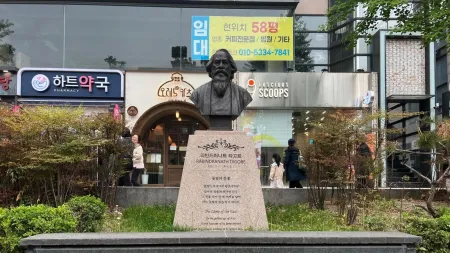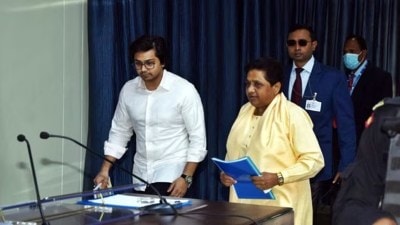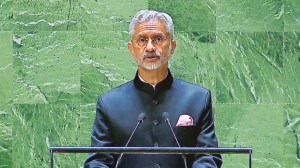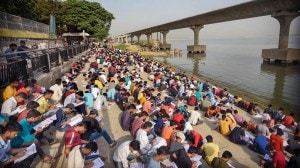- India
- International
Brahmins were not persecuted under Muslim rulers — arguing so goes against historical facts
Any sort of comparison between what Jews were made to go through in Europe and the experience of Brahmins in India reflects a lack of historical knowledge
 With this evidence about Brahmins thriving in these states — whether Hindu, Muslim or Christian — one does wonder where this sense of victimhood comes from. (Representative/ Express file photo by Nirmal Harindran)
With this evidence about Brahmins thriving in these states — whether Hindu, Muslim or Christian — one does wonder where this sense of victimhood comes from. (Representative/ Express file photo by Nirmal Harindran) Written by Sarthak Sharma
A recent article published in The Indian Express (‘Jews and Brahmins — West would like you to see them as oppressors alone. They are victims’, IE, October 12) about the anti-caste bill in California, which was recently vetoed, had an interesting title, and an even more interesting subheading. Following the recent developments in West Asia, the writer claimed an equivalence of historical experience between Jews and Brahmins as “both have a long, painful past in the history of Islamic and Christian imperialism around the world”. While I do not present an alternate view on the proposed and vetoed bill in the US here, this particular sentence needs to be investigated on a deeper level. One does, however, find it fascinating how the writer keeps talking about “Hinduphobia” implicit in the series of anti-caste legislation proposed in the West. Dalits are probably not part of the “Hindus” then against whom this apparent phobia is spreading.
A number of claims have been made by the adherents of Hindutva about the millions of Hindus killed by “Islamic imperialism”. This alludes to the historical reputation some of the “Muslim” rulers, especially the Mughal ruler Aurangzeb, have had in the popular imagination in India. One claim from recent times comes from The Great Big Book of Horrible Things by Matthew White. In it, 100 atrocities from world history have somehow been ranked. In the chapter about Aurangzeb, he claims that around 4.6 million were killed in the Deccan War and equated all that with the struggle for succession Aurangzeb had against his brothers, the conflicts with the Sikhs and the war against the Marathas. Yet, these conflicts were complex, involving Hindus and Muslims in various roles on all sides: The Brahmin brothers Madanna and Akkanna were at the apex of the Golconda Sultanate on the one side, and a large number of Maratha chieftains were on Aurangzeb’s side. The term “genocide” is thrown around carelessly, distorting any important nuance despite the many interpretations of it. The word is related to an intention to eliminate a particular people/group. How, then, does one carry out a “genocide” while also employing the same people? The figure of 4.6 million is most certainly an exaggeration from the selective reading of primary sources anyway: Even if Aurangzeb had direct intention of killing these many people, the technology and administrative systems of the time would not allow him to do so.
Rajputs (and Marathas) loom large in the books written on the Mughals — and rightfully so. But Brahmins too were a good part of this system, despite many of them not commanding armies or taxable areas like the Rajputs did. Raja Birbal, that character from the childhood of my generation was born a Brahmin and he died fighting for his emperor in the regions of Hindukush — military background or not, the Mughal system trained and expected every noble to be militarily competent. Before his death, Birbal commanded the fort at Kalinjar which is among the more strategically important strongholds of the Bundelkhand region. Another figure was Chandar Bhan Brahman whose remarkable career as a secretary and Persian littérateur even has a modern monograph dedicated to it by Rajeev Kinra. His stature within the Mughal system of secretaries was substantial, second only to one other Munshi in this class of officials.
This connection extended far beyond the imperial court, reaching into the sacred realms of temples and religious figures. Temples with pujaris as their devoted custodians received huge tracts of land as shown by the case of Gopaldas, who served as the priest of the Madan Mohan temple in receiving (an ever-increasing) 200 bighas of land as early as 1565. This exemplifies a deep-rooted relationship between Brahmins and Mughal rulers as the latter could identify the importance of the former in the day-to-day life of people; incorporating Brahmins in the system then, was an easy choice. Gopaldas, incidentally, was working within the Chaitanyite tradition, headed by figures like Rupa and Sanatana Goswami (Gopaldas was directly under Jiva Goswami, the nephew of the aforementioned Goswami brothers), and these brothers too held major positions under Alauddin Husain Shah of Bengal before they relocated to Vrindavan.
These are just some among many examples of how Brahmins were part of the system of rule and reflect the various ways they found themselves as the centre of favour from these empires, not the oppressed section within. One part of society however that did not have a share of power as the nobility of the Mughals, or any other state in India were the “untouchables”. We have to understand that these states did not reward the most competent persons as if they were ideal meritocracies — birth decided their fate. Except, this issue also had a major part of its roots in caste rather than religion. The emperor could be Muslim, Christian or Hindu — but that major part of society was always excluded.

During all this time when Brahmins were a part of these dynamic states, the Inquisition was in full force in modern-day Spain and Portugal alongwith their colonies and the order for all the Jews and Muslims was to flee from their homes. Many became “New Christians” (Jewish people who converted to Christianity to bypass the wrath of anti-semitism). Among these “New Christians” were individuals like Garcia de Orta and Fernando Rodrigues Caldeira, who, remarkably, found new lives serving at the courts of Ahmednagar and Golconda in the Deccan. Brahmins were never given such a grave choice in these very courts that these New Christians found refuge in, some in fact could climb the ladders of power as we just saw. What was really going on was far more complex and interesting; this was an intricate interplay of religion, religious violence, and statecraft during the early modern era, far from the simplistic understanding where certain enemies were bent upon destroying certain others. Religious violence was among the many tools used or discarded by the powerful who understood its strategic use, underscoring the need for a nuanced understanding from our side of this complex period.
With this evidence about Brahmins thriving in these states — whether Hindu, Muslim or Christian — one does wonder where this sense of victimhood comes from. What compelled the writer to create a false equivalence between the historical experience of Brahmins and that of Jews? Is it just the assertion of rights by people from marginalised communities who now demand equality on all fronts that makes the privileged insecure everywhere? Whatever the reason, drawing any sort of comparison between what Jews were made to go through in Europe and the experience of Brahmins in India reflects a lack of historical knowledge.
The writer works as a research assistant at MAP Academy and is currently pursuing Master’s in History
EXPRESS OPINION
More Explained
May 08: Latest News
- 01
- 02
- 03
- 04
- 05











































